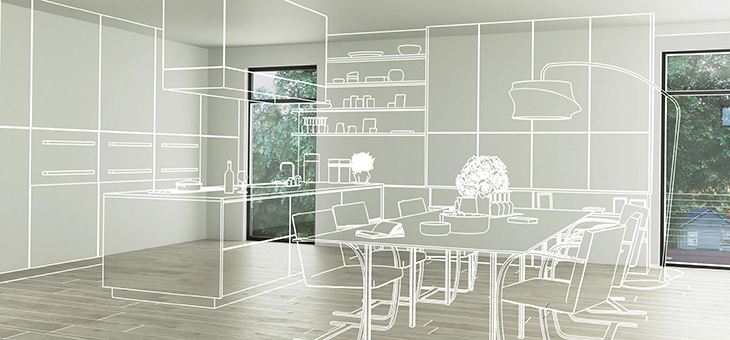With the ‘stay at home’ message having more staying power than we might have initially envisioned, home improvements and renovations are on the up.
Indeed, Houzz, the leading platform for home renovation and design, reported a surge in searches over the winter, with a 102 per cent increase in demand for home professionals during August, compared to the same period last year. So, it seems home extension projects are in high demand.
And with restrictions relaxing and tightening across the globe, it’s hardly surprising we’re looking to tackle jobs that lockdown highlighted, create more space or add a home office. Amid the joy and chaos this might bring, there are other things to consider, such as how to plan financially to keep a handle on the costs.
To help, professionals from the Houzz community reveal some of the key things to think about before starting any home improvements – and how to keep projects on track.
1. Plan ahead
If you haven’t renovated before, you may not realise the planning phase often takes longer than the construction work itself. It’s likely you will need to have decisions about style, layout, finishes and materials finalised before work begins, to avoid costly delays during construction.
A survey carried out in the UK found that homeowners took an average of five to 12 months to plan their projects, depending on the room. Kitchens, one of the most popular spaces to renovate, took an average of 10 months to plan, while construction took just over five months.
Planning for bathrooms, another room which tops the most-renovated charts, took more than seven months on average, with construction taking three months. It’s tempting to rush into a project, but it pays to take the time to plan thoroughly, and make sure you have everything prepared.
Miles Griffies of Red Squirrel Architects suggests putting together a bullet-point brief of your key objectives and requirements. “Start by giving a more general description of the project and the feel you’re trying to achieve,” he says. “Then create a list of requirements for each area, space or room of your home as you envisage it.”
2. Trust the pro
If you’re doing your project with the help of a professional, remember the point of hiring someone is for that person to manage your project, so you don’t have to.
Interior designer on Houzz Bhavin Taylor, of Bhavin Taylor Design (winner of the Evening Standard Home Design Awards 2019), explains: “When working with a designer, it’s extremely important that you let go and have full trust in them. There may be times when we suggest something that you’re not sure about or think we’re pushing you too far in terms of design; or times when we may not agree with your ideas or suggestions.
“And why do we do this? It’s simple – it’s not because we just want to do things our way, but because our ultimate goal is to give you the best possible outcome. If you do hire a professional, put all your trust in them and don’t feel that you have to watch their every move. Once you let go, you will really enjoy the benefits.”
3. Plan in a contingency fund
Budgeting for a project can be challenging and, according to Houzz, just 51 per cent of renovating homeowners hit their budgets in 2019. Of the homeowners who ended up over budget, deciding to buy more expensive products or materials and products or services turning out to be more costly than expected were the most common reasons.
When you’re planning for a renovation project, it’s important to account for the unexpected. “I would always recommend setting aside a contingency fund of 5–10 per cent of the total budget. Err towards the larger figure if you’re working on an older property, where more problems may be uncovered,” suggests Stephen Fletcher of Stephen Fletcher Architects.
4. Understand your estimates
When you receive a quote, it’s important to be clear on what’s included in the price. Denise O’Connor of Optimise Home advises: “Typically, the contractor will not include items such as windows, kitchens, bathroom fittings or finishes. These are referred to as client supply items and are sometimes given what’s called a provisional cost by the contractor in their pricing document.
“The provisional cost, also called a PC sum, refers to the estimated cost of something that the contractor assumes the client will supply.” Ensure you read estimates carefully, and query anything you’re unsure about.
5. Communicate
Having clear communication lines with your professional will be vital to staying on track and avoiding any delays. If you’re are unsure about anything, clarify before going ahead. It might be good to keep a record of all conversations so you can review what’s been proposed and approved.
Are you planning to renovate next year? What’s the biggest home improvement project you’ve undertaken?
– With PA
If you enjoy our content, don’t keep it to yourself. Share our free eNews with your friends and encourage them to sign up.
Related articles:
https://www.yourlifechoices.com.au/finance/property/increasing-the-value-of-your-home
https://www.yourlifechoices.com.au/finance/property/renovate-to-add-value–or-sell
https://www.yourlifechoices.com.au/lifestyle/leisure/brighten-up-your-bathroom-on-a-budget

